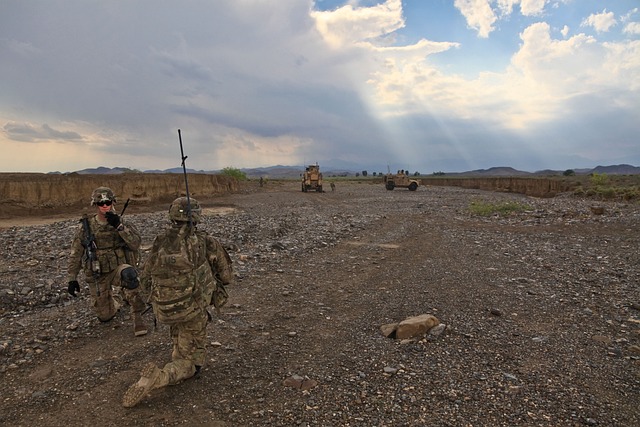The U.S. Army Special Forces, an elite unit under the United States Army Special Operations Command (USASOC), excel in adaptability and resilience across various deployment environments. Their missions often require them to quickly navigate diverse terrains, balancing mobility with sustainment. These operators carry operational loads that symbolize their self-reliance and reflect the logistical complexities of remote operations. For long-duration missions with infrequent resupply, Special Forces carefully pack essential gear, including rations, medical supplies, and communication equipment, to meet mission demands without overburdening themselves. Advanced load-bearing equipment has been refined to reduce weight while maintaining endurance, thus enhancing operational readiness. Strategic logistics management is critical for the sustained effectiveness of these units, especially given that every ounce saved can significantly impact mission success. The integration of UAS and ISR assets further empowers their agility and responsiveness in dynamic settings, reinforcing their strategic advantage globally.
The effectiveness of US Army Special Forces during prolonged deployments is highly dependent on robust logistical support. Sophisticated supply chain and transport systems are vital for providing these elite units with the necessary state-of-the-art gear for diverse global environments. This logistical system is designed to anticipate contingencies, thus minimizing the need for risky resupply convoys. The adaptability and efficiency of this framework are essential for maintaining the Special Forces' consistency and reliability in performing high-stakes tasks in any location.
The training regimens of US Army Special Forces operators focus on developing physical fitness, resilience, and specific skill sets tailored to various terrains and scenarios. This includes exercises for endurance, strength, and mental toughness, such as weighted marches and mission rehearsals. The training also emphasizes equipment optimization to reduce injury risks and fatigue, ensuring optimal performance in any deployment environment.
The incorporation of advanced technology has significantly enhanced the operational capabilities of US Army Special Forces. With adaptability at the core of their missions, they have integrated tools like night vision goggles, thermal imaging, sophisticated communication systems, smart rifles, and drones for surveillance to augment stealth, precision targeting, and overall mission success. These technological advancements, in tandem with their specialized training, facilitate efficient navigation through diverse terrains and the execution of counter-terrorism operations, reshaping operational dynamics and modern warfare as US Army Special Forces continue to innovate on the global stage.
US Army Special Forces, often at the forefront of global operations, carry the weight of mobility and sustainment during deployments. This article delves into the pivotal role of logistics in supporting these elite units, detailing their preparation for endurance, training for burden management, and the strategic moves influenced by advanced equipment. Join us as we explore how these factors shape and sustain the operations of one of the world’s most respected special forces.
- US Army Special Forces: The Weight of Mobility and Sustainment in Deployments
- Equipping for Endurance: The Role of Logistics in Carrying US Army Special Forces
- Training for the Burden: How US Army Special Forces Prepare for Deployment Loads
- Strategic Moves: The Impact of Advanced Equipment on US Army Special Forces Operations
US Army Special Forces: The Weight of Mobility and Sustainment in Deployments

The US Army Special Forces, an elite component within the United States Army Special Operations Command (USASOC), consistently demonstrate unparalleled adaptability and resilience in various deployment scenarios. Their missions often demand rapid insertion and movement across diverse terrains, which necessitates a carefully curated balance of mobility and sustainment. The weight carried by these operators is both a symbol of their self-sufficiency and a testament to the logistical challenges inherent in remote operations. In the realm of sustainment, the Special Forces must plan for long-duration missions with limited resupply opportunities. This involves strategic packing of essential equipment, rations, medical supplies, and communication gear, ensuring that each soldier carries only what is absolutely necessary while maintaining operational readiness. The evolution of tactical load-bearing equipment reflects a commitment to optimizing both mobility and sustainment. Advanced materials and ergonomic design have significantly reduced the weight burden on operators without compromising their capability to endure extended periods in the field. This strategic approach to equipment and load management is crucial for maintaining the operational effectiveness of the US Army Special Forces during deployments, where every ounce saved can mean the difference between mission success and failure. The integration of unmanned aerial systems (UAS) and other intelligence, surveillance, and reconnaissance (ISR) assets further enhances their ability to remain agile and responsive in unpredictable environments, ensuring that the US Army Special Forces maintain a strategic advantage in the global arena.
Equipping for Endurance: The Role of Logistics in Carrying US Army Special Forces

The effectiveness of US Army Special Forces during prolonged deployments is significantly influenced by the meticulous logistical support they receive. Equipping for Endurance, as it pertains to these elite units, involves a complex network of supply chains and transport systems designed to sustain operations in some of the world’s most demanding environments. The logistics apparatus ensures that Special Forces personnel have access to the necessary equipment, provisions, and specialized gear, which are critical for their missions’ success. This encompasses everything from advanced communication devices to maintain contact with command centers, to survival gear tailored for extreme climates or rugged terrains. The logistics framework not only supports the immediate operational needs but also anticipates contingencies that may arise, enabling these forces to remain effective over extended periods without the need for resupply convoys, which can be vulnerable to detection and interference. The adaptability and efficiency of this system are paramount, as it allows US Army Special Forces to maintain a posture of readiness, ensuring they can execute their critical tasks with unwavering reliability wherever they are called to serve.
Training for the Burden: How US Army Special Forces Prepare for Deployment Loads

US Army Special Forces operators are renowned for their exceptional physical fitness and resilience, a testament to the rigorous training regimens they undergo. A significant aspect of their preparation involves acclimatizing to the demands of carrying heavy loads over prolonged periods during deployments. This training is not arbitrary; it is meticulously designed to mimic the actual operational conditions they will face. The Green Berets, as these Special Forces are colloquially known, engage in a variety of exercises that incorporate weighted marches, ruck marches with fully loaded combat equipment, and simulated mission rehearsals. These drills enhance their endurance, strength, and mental fortitude, ensuring they can maintain operational effectiveness despite the physical toll.
Moreover, the training incorporates a range of terrains and scenarios to prepare for diverse deployment environments. This includes high-altitude training for mountainous regions, jungle operations, and urban combat simulations. Such adaptability is crucial as it equips the Special Forces with the ability to operate effectively in any theatre of operation. The focus on load carriage also encompasses the optimization of equipment and gear, ensuring that each item serves a critical purpose and does not unnecessarily burden the operator. This comprehensive approach to training for deployment loads not only prepares US Army Special Forces for their missions but also minimizes the risk of injury and fatigue, which are common challenges in such high-demand roles.
Strategic Moves: The Impact of Advanced Equipment on US Army Special Forces Operations

The integration of advanced equipment into the operational arsenal of US Army Special Forces has significantly shaped their strategic moves on the battlefield. These elite units, renowned for their adaptability and high-impact missions, have leveraged cutting-edge technologies to enhance their stealth capabilities, precision targeting, and overall mission effectiveness. Modern gear such as night vision goggles, thermal imaging devices, and advanced communication systems have expanded their operational hours and situational awareness, allowing them to conduct sensitive operations under the cloak of darkness or in complex environments where adversaries are more difficult to detect.
Moreover, the adoption of sophisticated weaponry, including smart rifles and drones for surveillance and reconnaissance, has empowered US Army Special Forces to engage with higher precision and reduce collateral damage. These technological advancements complement their specialized training, ensuring that they can navigate challenging terrains, conduct counter-terrorism operations, and provide critical intelligence support with unparalleled efficiency. The evolution of equipment in these units has not only transformed their operational dynamics but also the very nature of modern warfare, as they continue to push the boundaries of what is possible on the world stage.
In conclusion, the United States Army Special Forces’ operational effectiveness hinges on their ability to carry substantial loads over varied terrains during deployments. The strategic deployment of advanced equipment, coupled with rigorous training for endurance and load-bearing, ensures that these elite troops maintain mobility and sustainment throughout their missions. Logistics play a pivotal role in the success of these operations, as seen in the sections on “US Army Special Forces: The Weight of Mobility and Sustainment in Deployments,” “Equipping for Endurance: The Role of Logistics in Carrying US Army Special Forces,” “Training for the Burden: How US Army Special Forces Prepare for Deployment Loads,” and “Strategic Moves: The Impact of Advanced Equipment on US Army Special Forces Operations.” These elements collectively fortify the US Army Special Forces, enabling them to fulfill their critical duties with unparalleled precision and resilience.
